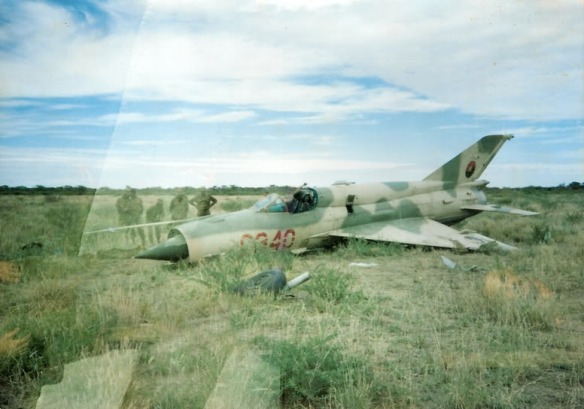On 6th November 1981 the Mirage F1-CZ got it’s first test as an interceptor. Two Mirage F1-CZ’s flown by Major JJ Rankin and Lt. J du Plessis were scrambled from AFB Ondangwa to intercept two MiG-21 MF’s. Lt. du Plessis tried twice to engage one of the MiG-21MF’s but on both occasions his missiles failed to engage. Major Rankin flying Mirage F1-CZ ‘213’ could also not lock his missile due to the proximity of the sun but opened fire with his 30mm DEFA cannons which caused Lt. Danacio Valdez’s MiG-21MF to explode and was seen to break in half. Lt. Valdez was seen to eject but did not survive. This was the first confirmed SAAF kill since the Korean War.
1982 was a year of mixed fortunes for the SAAF. On 1 June an Impala Mk II, piloted by Major Gene Kotze, was successfully brought down by enemy anti-aircraft fire while diving to attack a SWAPO target inside Angola. The aircraft crashed, killing the pilot instantly. Then, two months later, on 9 August, a fully loaded Puma was brought down near Cassinga by either a direct hit from a ground-fired RPG-7 rocket or a 23mm AAA – reports on the matter differ – killing pilot Captain John Twaddle, co-pilot Lieutenant Chris Petersen, technician Sergeant Grobler and all 12 paratroopers on board.
Matters were put right, however, when 3 Squadron’s Major Johan Rankin, this time flying with Captain Cobus Toerien as his wingman, successfully brought down another Angolan MiG-21 in aerial combat. On this occasion the F1CZs were tasked to escort an extremely vulnerable and very valuable Canberra on a small-area photo-reconnaissance mission over the Cahama area for the purpose of updating intelligence. At 11h20 the two fighters rendezvoused with the Canberra and, under positive radar control, the three-ship formation set a course for Cahama. Very quickly, however, radar fighter-control picked up approaching enemy aircraft and ordered the Canberra back while instructing the two fighters to climb to 30,000 feet and accelerate to Mach 0.95, the limiting speed for external fuel tanks. This positioned the opposing formations nose-to-nose, 12 nautical miles apart and closing at twice the speed of sound.
Major Rankin observed two MiG-21s on the same level as him, some five nautical miles distant, flashing past on his starboard side. The two F1 pilots shed their drop tanks, went into afterburner and commenced a hard right-hand turn in pursuit. Moments before the two formations crossed, the MiGs fired their missiles but they had no chance then of guiding correctly. In the meanwhile, the F1s completed their 180-degree turn as the MiGs were turning smoothly to the right, preserving their supersonic speed. Radar confirmed that they were inching ahead of the F1s and out of firing range. Unable to close, Rankin switched his intercept radar onto transmit in the hope that the MiG radar warning receiver would alert their pilots and force them to turn into the F1s. This was indeed what happened, whether as a result of the radar warning or simply because they were still focused on intercepting the Canberra, will never be known, but the sudden change of vector allowed the F1s to cut the corner and close the range.
The two South African fighters then performed an energy acceleration, reaching Mach 1.3 as they entered a curve of pursuit. Rankin made a snap estimation of range and, although his radar had not locked onto the target, he let loose a Matra 550 infrared missile which tracked the MiG until it reached all-burnt range before it fell away. Subsequent examination of the gun-camera footage revealed that the missile had been fired at 3,000 metres, the outer limit of its range at such speeds.
Continuing to close range, however, Rankin fired his second missile from a more practical range of 1,500 metres and this time the missile tracked the MiG which had begun a descending split-S manoeuvre, exploding right behind it.
The MiG was hit, and badly damaged, but still controllable. It slipped the net, continuing its left-hand roll before levelling out and running for home ahead of a trail of smoke. Later intelligence revealed that the damaged craft reached base but was unable to lower its undercarriage and was further damaged in a crash landing.
The remaining MiG, however, still had a fight on its hands and entered a split-S turn to the left with Rankin hard on its tail and overtaking rapidly. At a range of 200 metres the South African opened fire with his 30mm cannons, hitting the MiG which exploded directly in front of him, forcing the F1 through the expanding fireball which resulted in an engine compressor stall. Only after cutting the engine and performing a hot-relight was Rankin back in the game.
